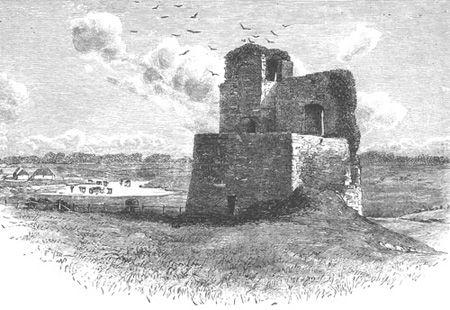Kilcolman Castle - Irish Pictures (1888)
From Irish Pictures Drawn with Pen and Pencil (1888) by Richard Lovett
Chapter IV: From Dublin to Cork … continued
« Previous Page | Start of Chapter | Book Contents | Next Page »
About two miles to the north-west of Doneraile, a small town on the Awbeg, are the ruins of Kilcolman Castle, for ten years the home of Spenser. Judging from present appearance, it can never have been a cheerful abode. It was a fairly strong keep, as every gentleman's house had to be in those stormy, troublous times; the rooms are small, and the arrangements for the comfort of the occupant seem to have been so necessarily imperfect that the visitor does not feel much desire for a return of those 'good old times,' at any rate if this should involve a return to such residences as the poet's home. This applies only to the castle itself, for the surroundings were very lovely.
'The castle,' writes Charles Smith, in his Natural and Civil History of the County and City of Cork, 'is now almost level with the ground, and was situated on the north side of a fine lake, in the midst of a vast plain, terminated to the east by the county of Waterford mountains; Ballyhowra Hills to the north, or, as Spenser terms them, the Mountains of Mole, Nagle Mountains to the south, and the Mountains of Kerry to the west. It commanded a view of above half the breadth of Ireland; and must have been, when the adjacent uplands were wooded, a most pleasant and romantic situation.'
It was here that Spenser learned some of the deepest lessons of life. Driven into himself by the uncongenial nature of his surroundings, compelled to practise self-denial, he entered into fuller communion with the natural beauties around him. Here he passed through some of the uncertainties of a long but at the last successful wooing; and here he enjoyed the happiness of a married life based upon deep and ardent affection. Thus taught and thus disciplined, he learned those truths which he afterwards so beautifully expressed in his Hymne of Heavenly Love, in which the poet shows that he had learned the true secret of the Gospel. After describing how:
Man, forgetful of his Master's grace,
No less than angels, whom he did ensue,
Fell from the hope of promised heavenly place
Into the mouth of death, to sinners due,
And all his offspring into thraldom threw,
and how the Lord Jesus Christ
Out of the bosom of eternal blisse
In which He reigned with His glorious Sire,
He down descended, like a most demisse
And abject thrall in flesh's frail attire,
That He for him might pay Sin's deadly hire,
And him restore unto that happy state
In which he stood before his hapless fate.
the poet goes on to ask—
How can we Thee requite for all this good?
Or what can prize that Thy most precious blood?
Yet nought Thou ask'st in lieu of all this love
But love of us, for guerdon of Thy pain:
Ay, me! what can us lesse than that behove?
Had He required life for us again,
Had it been wrong to ask His owne with gain?
He gave us life, He it restored lost;
Then life were least, that us so little cost.
But He our life hath left unto us free;
Free that was thrall, and blessed that was banned;
He aught demands but that we loving be,
As He Himself hath loved us afore-hand,
And bound thereto with an eternal band,
Him first to love that was so dearly bought,
And next our brethren, to His image wrought.
The years which Spenser passed at Kilcolman were among the most eventful in the whole course of English history. He came to Ireland in 1580 with the Deputy, Lord Grey de Wilton, and for about eight years he seems to have resided in or near Dublin. In all probability 1583 was the year in which he began his residence at Kilcolman. While he dreamed and chafed during these years of unwelcome banishment from England, Sidney died in Holland, the beautiful but wicked Mary Queen of Scots perished on the scaffold, the Armada came and was destroyed, and England emerged from her life and death conflict with Spain and the Papacy, victorious and with such triumphant energy that she left medievalism behind for ever, and took her place in the van of modern life and progress. Spenser felt most keenly the loss of his friend and typical hero, Sir Philip Sidney, and has enshrined his grief in noble verse. In the struggle known as Tyrone's Insurrection, Kilcolman Castle was attacked and burned, Spenser and his family escaping only with very great difficulty, and according to some accounts with the loss of an infant child, who was burned with the castle.
« Previous Page | Start of Chapter | Book Contents | Next Page »

